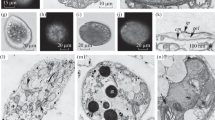Abstract
We followed changes in the neutral lipid content of actively swimming zoospores of the palm kelp Pterygophora californica in a laboratory experiment to investigate the degree to which spore swimming is fueled by endogenous lipid reserves. The neutral lipid content of individual zoospores during the experiment was measured by flow cytometry using Nile Red, a fluorescent stain that is specific for neutral lipid. Results showed that photosynthesis greatly influenced lipid consumption during zoospore swimming. We found no detectable change in the neutral lipid content of zoospores after 30 h of swimming under conditions where light was near the optimum for photosynthesis. By contrast, neutral lipid declined by ≃43% over 30 h in zoospores kept in the dark. To evaluate whether lipid reserves are generally related to spore motility in macroalgae, we surveyed spore lipid-content and composition in species with motile spores and non-motile spores using thin-layer chromatography (TLC), and flame-ionization detection (FID). We observed substantial differences in lipid content and composition among the 20 species examined. Spores high in total lipid (as estimated by the ratio of lipid:carbon) generally had a large amount of neutral lipid; motile spores had significantly more lipid and a significantly larger neutral lipid fraction than non-motile spores. The kelps as a group had the highest total lipid content and the largest neutral lipid fraction, while non-motile spores of red algae were generally low in total lipid and in the proportional abundance of neutral lipid. Phospholipids accounted for more than half of all lipid in 14 of the 20 species examined, while neutral lipid accounted for the majority of lipid in all five species of kelp examined. Triacylglycerols, which function primarily in energy storage, were the primary form of neutral lipid in all but one species of kelp (Agarum fimbriatum), whereas free fatty acids were the dominant form of neutral lipid in most red algae and in brown algae that had a small neutral lipid fraction. Our results are largely consistent with the hypothesis that macroalgae use endogenous lipid reserves to fuel spore-swimming. The small amounts of triacylglycerols observed in the motile spores of several species of brown and green algae, however, indicate that the amount of lipid reserves needed to fuel spore-swimming may be influenced by a variety of factors including swimming behavior, photosynthetic efficiency, and the light environment inhabited by spores.
Similar content being viewed by others
Author information
Authors and Affiliations
Additional information
Received: 8 September 1998 / Accepted: 8 January 1999
Rights and permissions
About this article
Cite this article
Reed, D., Brzezinski, M., Coury, D. et al. Neutral lipids in macroalgal spores and their role in swimming. Marine Biology 133, 737–744 (1999). https://doi.org/10.1007/s002270050515
Issue Date:
DOI: https://doi.org/10.1007/s002270050515




